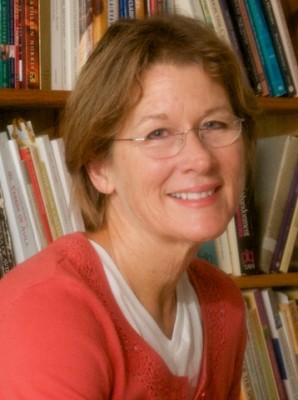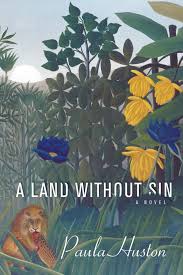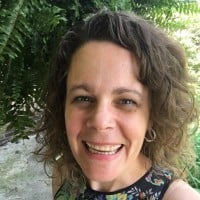I get just a weeeeee lot excited when a new novel by an author I love is released. And Paula Huston is one such author. Her new novel, A Land Without Sin, is well worth your time and money. I read it in a weekend (not intending to, mind you) and I'll be recommending it to my fiction book club, sharing it, and rereading it at some point.

Paula's been writing for years and years, though it's been 18 years since her last (and first) novel was released. In that time, she's written a number of nonfiction books (which are great!).
Today, she was kind enough to chat with me about motherhood and writing and novels. Enjoy!
Paula, I know a lot of moms who have great stories in them. What made you finally write this novel after writing so much nonfiction over the years?
Actually, I was a short story writer and novelist long before I began writing spiritual nonfiction. In fact, I wrote my first “novel” when I was only seven, as soon as they taught me cursive writing near the end of first grade. The hero of my novel was a genius-level German Shepherd named King, who looked and behaved an awful lot like Rin Tin Tin (obviously, I hadn’t yet heard about plagiarism). So my love of story goes way back, and once my first novel was finally published in 1995, I figured my course was set. But then my publisher, Random House, decided they didn’t want my second novel after all, and suddenly everything was up for grabs. Thank heaven I met a wonderful Catholic editor just then who talked me into trying spiritual nonfiction. He pointed me toward writers I’d not yet read and assured me that even though I did not have a background in theology, I had something to say about the spiritual life. It was a steep learning curve, but I found that my background in story-telling via fiction writing was a big help. In the past ten-plus years I published six books in this genre but kept wishing I could work on a novel again. Then last summer I got an email from another editor friend who was launching a new literary imprint and wanted to know if I had anything to show him. I did! I sent him that long-ago never-published novel, he loved it, and with the help of his insightful questions, I completely rewrote the book, which I can say is much better than it was in 1997. It really feels like I’ve come full circle--back to my first love--in a way I never could have arranged for myself, and I’m incredibly thankful for a second chance with this project.
This isn’t your first novel. How did the process of writing one differ (or stay the same) as your last? Were the challenges similar?
I wrote my first novel, Daughters of Song, in the early nineties, long before Google. The story is set in a famous music conservatory in Baltimore and the main character is a classical piano student. I’m not a musician--not even close--but one of my sisters is a professional pianist, so I relied heavily on her input. I also did a lot of library research and traveled back to Baltimore to make sure I got everything right. When I wrote the second novel, the one that became A Land Without Sin, the process was the same, only this time, since I was talking about early-nineties current events, I spent hours squinting at micro fiche rolls of newspaper clippings in the university library. Let me tell you, that is an incredibly laborious way to do research. Rewriting this novel in 2012 was a comparative breeze. Even though online research is not always totally reliable, there is now so much available that it is pretty easy to spot phony or inaccurate information. As far as the other aspects of novel writing go, I think the hardest draft is always the first one. You have absolutely no idea where you are going, and so many of the unconscious connections have not yet revealed themselves. That eighteen-year gap between the first draft of A Land Without Sin and the current version gave me plenty of what writers like to call “distance” on the project, and I found that it was very easy to pick up where I left off, and much easier to see the bones of the story in a way I did not the first time around.
With so many intriguing novels on the shelves these days, what makes yours different? Tell us why we shouldn’t wait to get a copy and share it with five friends.
Oh, gosh. It’s true--there ARE a lot of good books out there these days. So why should you spend your hard-earned money on A Land Without Sin? I would say that you should only do that if you are a certain kind of reader. First, you must like a good mystery--this book has three of them going at the same time. Second, you should be very character-oriented. I believe that the downfall of a lot of mysteries is that they sell out to plot and don’t give enough time to character development. For me, the best books and movies have always been about characters I can’t forget--people I keep thinking about and worrying about even after the story is done. I can guarantee that you won’t find any “cardboard” characters in this book. Third, you should like discussing books with other people, whether via a book club or an online discussion group. This novel has so many different facets to it that you’ll get more out of it if you share your questions and insights with others. Finally, you should be the kind of reader who likes to expand your pool of knowledge and is willing to move more slowly through a story in order to absorb new information than you would be if you were totally plot oriented and just racing to the end to see how it all turns out. This book is set in an exotic location--the jungles of Central America--and one of the characters is an archeologist who works in the Maya ruins, so there is a lot of information about that lost civilization. Another character is a priest who has spent years searching for answers to some of the big questions of life, including the problem of evil, so you’ll be getting his philosophical ponderings. The main character, Eva, is a young battlefield photojournalist, so you’ll be learning a lot about that particular profession. In other words, it’s not a quick read. On the other hand, my absolute toughest critic, the very guy who happens to be my husband and who often nods off when he is dutifully trying to read my latest book of spiritual nonfiction, swears he couldn’t put this one down. I thought that was a great sign!
Paula, you are a creative writing teacher, which I’m guessing also means that you’re patient to the extreme. How did that impact your writing this novel?
Well, I don’t know about being “patient to the extreme” (just ask that husband of mine), but I can say this; working with students does teach you to look at life through a wide angle lens. As does writing. Both develop slowly. Young writers are not formed overnight. And novels take forever. The best editors I’ve had are people who understand this and don’t rush their writers. They know how important it is to let the mind go completely fallow for long periods of time. They know that there’s a lengthy fermentation process once the creative project is underway. Deadlines can be deadly because they introduce an artificial element into that process (though they can also be very good spurs in regard to developing writing discipline). I read something really helpful the other day in regard to the life of faith, which can easily be applied to the creative life and the teaching life besides. This was that, as Christians, we should think of ourselves as “sowers” rather than “reapers.” In other words, what we need to worry about is planting the seeds--God himself will bring in the harvest. Whether I’m teaching or writing novels, all I can do is plant those seeds. Thinking of myself as a sower helps me be more patient.
What advice and encouragement would you give other moms who love to write?
The same advice I have given to my own daughters, particularly my painter daughter, which is to practice your art as much as you possibly can even when your kids are small and it seems like you have no discretionary time whatsoever. Even when you are too exhausted to think straight. It can be terribly frustrating to start working on a creative project and then be interrupted by family demands--frustration is a given here. The temptation, however, is to just set your artistic aspirations aside until some mythical time when you’ll be freed up to pursue it at your leisure. But if you are no longer thinking about stories and trying to work out plots--no longer spending part of each day, no matter how briefly, at your computer--you stop developing as a writer. You stagnate. And then you begin to lose self-confidence, and finally you are sheepishly looking back on your former-but-now-outdated artistic “idealism.” When you finally do get the time, it is often too late: you’ve lost that sense of calling and it just seems too hard to try to catch up at this point. That’s why I tell all would-be writer moms to get serious about developing your craft now--to work out a schedule that gives you time you can count on, even if it’s minimal, and then stick with that through thick and thin. This way, you’ll keep learning and growing as a writer, even during the years when you can’t yet take on a major creative project.

Here's an excerpt of A Land Without Sin, used with permission of the publisher.
Remember, when you buy using our affiliate links, you help CatholicMom.com without paying any extra.
Tikal, Guatemala, 1993
I was looking for my brother. Whether or not Stefan even wanted to be found, I did not know. By now he could be the neo-Che of the Lacandon jungle, or lying in his own filth in a Chiapan jail, or even dead. Because of the way our family is, we’d only been in the same country at the same time on a very sporadic basis for the past sixteen years, the most recent occasion being his priestly ordination, so it was hard to say what was going on with him. But I was ready for anything.
In my clothes were sewn a false passport bearing a two-year-old photograph of him, the best I could do, and a one-way ticket out of Mexico, in case we had to scramble. And because I didn’t know whose list he might be on, I had a fake passport of my own, one made for me when I dated a USIA man stationed in Burma. This USIA man’s theory was that no American female could be overly prepared for extended stays in international hotspots, and since it looked like that’s where I would be spending my time, I took him up on his offer. A helpful fellow indeed, he also taught me to throw a knife, a handy trick he no doubt picked up in CIA school, even though he would never admit he’d been.
Besides the false passport, I had a false job, thanks to a fellow freelancer I first met while I was still schlepping my cameras through war zones on behalf of the Associated Press. I bumped into Dirk a few months ago in Burundi, right about the time I heard about Stefan’s disappearance. Dirk told me that a Mayanist named Bource was looking for a good photographer who was used to roughing it and used to the jungle and didn’t care about making campesino wages for the next couple of months. Given the annual income of most freelancers, this could have been almost anyone--under normal circumstances, it would have certainly been Dirk, who would go anywhere, anytime, as long as there was a good chance of dying in a heroic manner and/or securing himself a book contract with a major publisher. But Dirk was getting married, a recent trend among my footloose cronies. I’m thirty-eight, he said, as though that would explain it.However, thanks to Dirk’s new direction in life, I now had my cover and an airtight excuse for snooping around in Central America, where I had not been for nearly ten years and which I had not missed in the slightest.
My false boss for the false job, Bource, turned out to be a bespectacled, formerly-handsome Dutchman in a red baseball cap who asked me, in a gloomy, preoccupied way, to please call him Jan. He, of course, did not know he was helping me in my scam and clearly was not the kind of man who would understand the need for duplicity. He’d told me to meet him in Guatemala, in the island town of Flores, which was not exactly where I needed to be. But we were at least pointed in the right direction, and I could afford to be patient.
Jan’s son, Rikki, a mere sixteen but already, I noticed, a stunning young pre-man, was extremely efficient and not at all gloomy, and the family truck, as his father had requested, was loaded and ready to roll at 3:30 that afternoon. We were headed for Tikal, perhaps the only Maya site in Guatemala with one hundred percent name recognition, though I myself, being more focused on current events than dead civilizations, had always vaguely supposed it to be in Honduras. I’d been set straight on this by my Aviateca Airlines seat-mate, a bearded Berkeley rainforest savior headed for the Biosphere Reserve, and his lecture pretty much covered my knowledge of the Mayas.
Riding around in remote places with strange men was something I was used to, and in spite of the big question mark concerning my brother, I could feel myself getting primed for a new adventure. I knew a dog once who ran like a racehorse, tongue streaming back, black ears flying, and who could run like that for hours and then go unconscious for half a day in the sun, twitching and dreaming, and then wake up and start running again. There was nothing this dog was running toward, nothing it was trying to catch. Running was it, pure and simple. That was me at the start of something new.
Be sure to check out our Book Notes archive.
Copyright 2013, Sarah Reinhard
About the Author

Sarah Reinhard
When she’s not chasing kids, chugging coffee, or juggling work, Sarah Reinhard’s usually trying to stay up read just one … more … chapter. She writes and works in the midst of rural farm life with little ones underfoot. She is part of the team for the award-winning Catholic Mom’s Prayer Companion, as well as the author of a number of books.



.png?width=1806&height=731&name=CatholicMom_hcfm_logo1_pos_871c_2728c%20(002).png)
Comments